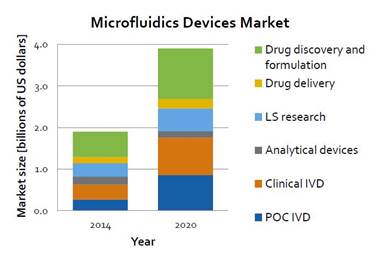Microfluidics in health care to reach nearly $4bn by 2020
Microfluidics can offer portable, cheap, single-use devices that replace centralised laboratory equipment in health care facilities and open new point-of-care diagnostic opportunities. Driven by in-vitro diagnostics and robust demand in developing nations as the technology advances and medicine grows more personalised, the overall health care market for microfluidics will swell to nearly $4bn in 2020, growing at a CAGR of 13%, according to Lux Research.
“Microfluidics has numerous potential applications in health care, including drug discovery, formulation, and delivery, as well as life sciences research,” said Milos Todorovic, Analyst, Lux Research, and lead author of the report Health Care Microfluidics Value Chain: A Story of Growing Pains. “However, point-of-care diagnostics is going to be the biggest opportunity for microfluidics, with markets in the developing world providing the greatest growth.”

The typical value chain for microfluidics remains undifferentiated, offering opportunities for vertical integration. Lux Research expects two types of companies to eventually dominate the microfluidics value chain – chip developers/manufacturers like miniFAB or Sony DADC and device integrators like Agilent or Fluidigm.
End device integrators that bring together device design, manufacturing and microfluidics devices will capture nearly 50% of the profit pool. Material suppliers will account for about 24%, while sensing solutions, manufacturing and design services share the rest.
Point-of-care diagnostics will grow at 20% CAGR, driven by low-cost, portable diagnostics solutions for applications in infectious diseases and lifestyle-related conditions. Drug discovery and formulation will remain a leading use, with $1.2bn in 2020.


